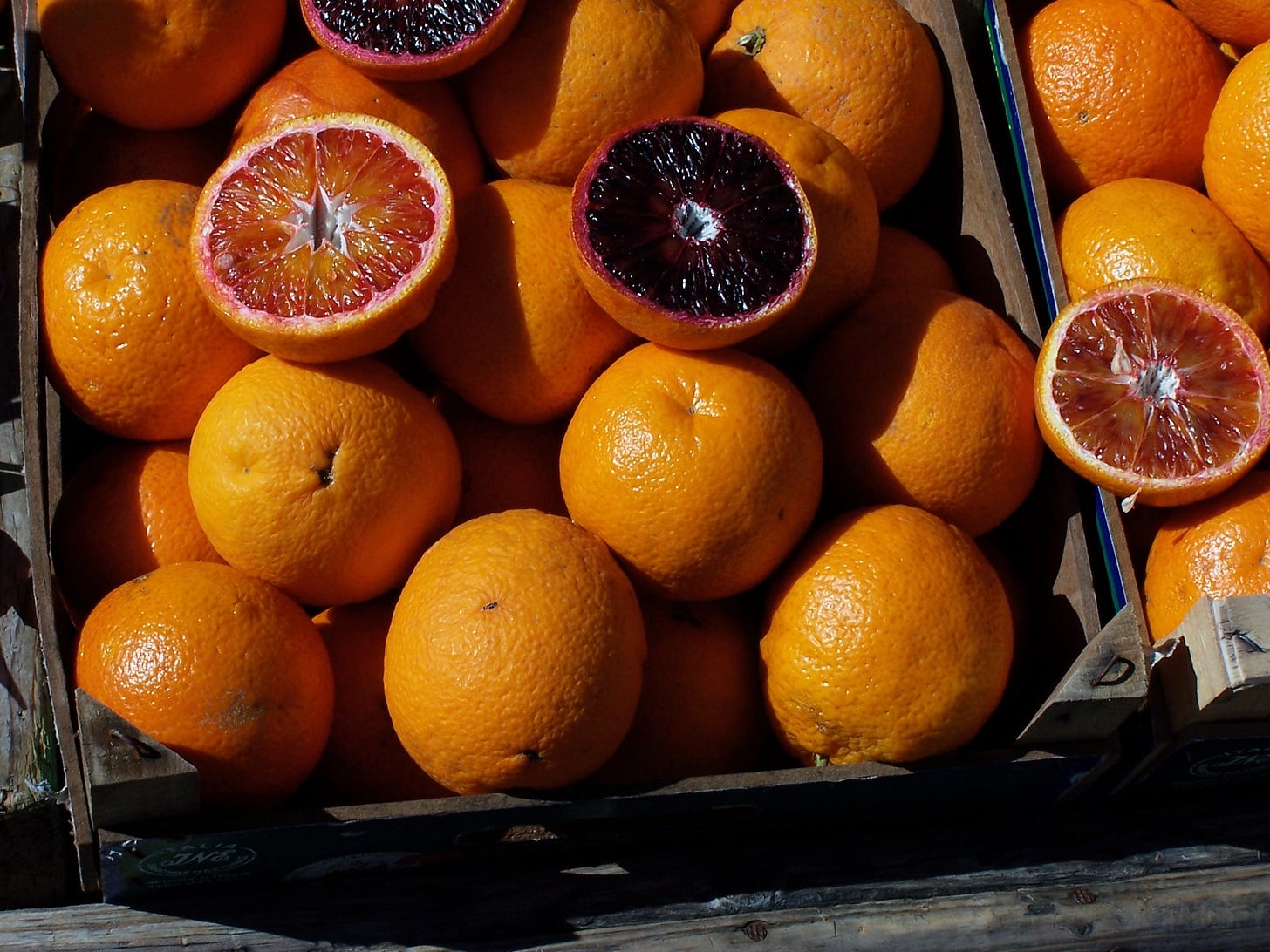SNOW! The first snowfall of the season always steals in like magic overnight and you wake in the morning to a white world, the snowfall’s hushed whisper broken only by the rumble of the town plow clearing the streets for early traffic. It’s a blessing that often comes as a delightful surprise, as it did last night, but, I caution, ask me about that delight come March and I may have a different attitude. For now, though, it’s a rare treat that restores our bleak northern world to splendor and makes me very happy.
My mother always made sure there was something to eat in our Christmas stockings, like the ritualistic orange in the toe--a reminder, she said, that in her Maine childhood it might be her only orange of the year. Also tucked in there would be a package of soft, sweet maple sugar shaped in the form of a little pilgrim man or woman. I always ate the pilgrim's head first, in one bite, while my sister nibbled slowly, from the feet up, and savored the sweet, annoyingly, all day. "Mmm, so good," she would murmur, long after mine was gone.
Nowadays I look for other food treats in the stockings I hang by the chimney with care. The ideal stocking gift should be, of course, small, but exquisite and possibly quite expensive. Best of all would be a couple of ounces of Iranian caviar with a mother-of-pearl spoon for sampling, but that's not likely these days.
Instead, I could be happy, more prosaically, with a jar of some exotic and unusual spice that can't be found on supermarket shelves, something like piment d'Espelette, the delicious flaked or ground red chili from the Basque Pyrenees of southwest France with its own AOP (appellation d’origine protégée), protected name. I like to keep a jar of this next to my stove to liberally scatter over soups and stews, atop cabbage-y things such as Brussels sprouts, but especially on any egg dish, poached, boiled, scrambled or fried. Piment d'Espelette is warm rather than hot, and profoundly fragrant, like a freshly roasted red pepper but with the kick, slight but unmistakable, of a true chili. Prices range greatly depending on the supplier but be sure you get piment d’Espelette AOP, to have the genuine article. (There’s a California producer who grows from Espelette seeds, but of course the terroir and the climate are totally different and so is the spice.) I usually get mine from Market Hall Foods in Oakland, CA, but they are currently out of it. A jar with an ounce of pepper flakes costs $24.99 from Kalustyan’s in New York City. And yes, it’s expensive, but worth every penny. Amazon offers 1.4 ounces for $16.92, and Matiz, also on Amazon, has 1.58 ounces for $13.49. I suggest surfing to find the best price, making sure it’s AOP Piment d’Espelette.
If your stocking toe is big enough, you should be able to fit in it a 250 ml/8 oz. bottle of brand new, freshly milled, unfiltered, California olive oil. Olio Nuovo from Seka Hills is just $20, plus shipping, and you can get it straight from the farm. This is one of my favorite California oils, bottled directly after milling, meaning it has all the bright, chewy flavors and the grassy fragrance of a fresh-from-the-mill oil, the kind that those of us outside the borders of olive country seldom get to appreciate. A further benefit, to my mind, is the support this lends to the Yocha Dehe Wintun Nation, a Native American tribe that is responsible for this treasure. Check out other offerings on their website too. Olio Nuovo is a special product, but their regular oil, also from this season but filtered for longer keeping, will be ready in January.
A great flavor booster that will fill any stocking with enticing Christmas-y aromas is za’atar, the Middle Eastern (think Lebanese, Syrian, Jordanian, Palestinian) herbal mix, usually made by combining tangy red sumac, nutty sesame seeds, and pungent dried wild herbs in the oregano/marjoram family. (Confusingly the herb itself is also called za’atar, as pictured here.)
The balance of these ingredients changes from one region to another (actually, to be honest, from one household to another) but I’m very partial to Kamã za’atar from Jordan, with its warm, sunny, woodsy fragrance. Try it with a dollop of extra-virgin on a soft-boiled egg for breakfast, or sprinkle it over plain thick (“Greek”) yogurt to pile on toast, or mix it with olive oil and rub it over chicken before roasting. The Rogers Collection imports Kamã za’atar. Find it here.
From Sicily, a flavorful candidate for the Christmas stocking is estratto di pomodoro, sometimes just called ‘stratto or 'strattu in dialect, a rich, thick quintessence of tomatoes that puts any other tomato paste to shame. Traditionally, Sicilian householders crush tomatoes into a paste, spread it on boards to dry in the intense September sun to a thick concentrate, then pack it in jars with sea salt and a protective layer of extra virgin. Pastry chef Maria Grammatico makes her estratto di pomodoro in the hilltop village of Erice in far western Sicily. Her pastries are deservedly praised (see Mary Taylor Simeti's culinary biography, Bitter Almonds), but her estratto di pomodoro could make her fortune as she insists on the old-fashioned, handmade, artisanal process. It costs $18.95 for a 100-gram (about 3.5 ounces) jar at Market Hall Foods; Zingerman's has a similar product from southern Sicily called Strattu, $15 for 180 grams (6 ounces), and gustiamo.com offers Lorenzo Piccione's Pianogrillo Estratto, made from his mother’s own recipe and deliciously flavored with Sicilian bay leaves, at $30.50 for 330 grams/11.6ounces. These may be expensive, but just a dollop stirred into a chick pea stew or a pasta sauce, or melted in olive oil in a saucepan at the start of a recipe, will light up a dish with all the brilliance of the Sicilian sun. Use a little at a time and cover what remains in the jar with a thin layer of olive oil--extra virgin, of course.
Finally, my all-time favorite flavoring, ever since I found it when I first went to live in Tuscany a good many years ago--wild fennel pollen, polline di finochietto, gathered from the umbelliferous blossoms of wild fennel late in summer just after the flowers have peaked. This is the secret ingredient that flavors Tuscan pork dishes from fresh sausages to cured finocchiona, a salami studded with chunks of tender pork fat, to porchetta, the world-famous Tuscan slow-roasted pork.
Wild fennel pollen has an incredibly deep, penetrating fragrance that smells and tastes just like a Tuscan meadow on a hot August afternoon. Note that this is wild fennel, related to but quite different from the kind of bulb or Florentine fennel that gets sliced into salads. It has the same anise or licorice notes but it’s . . . well, quite simply, it's wilder. It's terrific in rabbit dishes too, especially roasted in a Tuscan wood-fired oven, and with certain types of seafood: think grilled scallops, or a handsome zuppa di pesce, fish stew. At Zingerman’s, a jar of fennel pollen weighing 1.58 ounces is $30 and is said to be hand-selected by Dario Cecchini, the world’s most famous Tuscan butcher, who uses the product liberally in all his salumi. A 1.5 ounce jar of Francioni Fiore di Finocchio at Market Hall Foods costs $15. In fact, I might go for broke and order the 7 ounce package at $64.95. You will be surprised how many uses you may find for it.
The rest of this post is for paid subscribers. Just click on the button to join me on the Kitchen Porch:
Keep reading with a 7-day free trial
Subscribe to On the Kitchen Porch to keep reading this post and get 7 days of free access to the full post archives.









